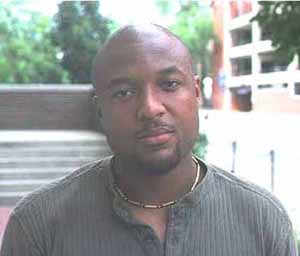
Charles Isbell

birth:
place: Chattanooga, TN (raised in Atlanta, Georgia)
.education.gif)
 Massachusettes
Institute of Technology
Massachusettes
Institute of Technology
 assistant professor
college of computing at Georgia Institute of Technology
assistant professor
college of computing at Georgia Institute of Technology
URL: http://www.cc.gatech.edu/fac/Charles.Isbell/
Charles Isbell earned a BS (1990) from Georgia Institute of
Technology, Information and Computer Sciences. He went to MIT
from Ga Tech's College of Computing in order to earn a PhD doing
Machine Learning. Isbell got his PH.D. from Massachusettes Institute
of Technology, Electrical Engineering & Computer Science (1998)
in MIT's Artificial Intelligence LAB. He has 13 publications from
his time in graduate school. Before his degree he also worked
at Lucent Technologies and at AT&T Shannon Labs Artificial
Intelligence Principles Research Department.
"My research centers around machine learning and, in
particular, unsupervised learning. For my dissertation, I developed
a novel algorithm for inferring sparse, multi-level structure
from a large collection of electronically-available text. This
is done in an unsupervised way, using principles from statistics
and information theory. This structure is then used to group
related documents for the purposes of effective retrieval. As
this technique is related to sparse factorial codes, independent
components analysis, and projection pursuit, the principles used
here should apply to retrieval in non-textual domains and have
implications for completely different tasks as well, such as
data visualization."
Publications
Note the collaborations with Black Computer
Scientist Parry Husbands.
- C. Isbell, O. Omojokun and J. Pierce. From
Devices to Tasks: Automatic Task Prediction for Personalized
Appliance Control. In Proceedings of 2AD, 2004. A version
of this paper will appear in Personal and Ubiquitous Computing.
- B. Landry, J. Pierce, and C. Isbell. Supporting
Routine Decision-Making with a Next-Generation Alarm Clock. In
Proceedings of 2AD, 2004. A version of this paper will appear
in Personal and Ubiquitous Computing.
- O. Omojokun, and C. Isbell. User Modelling
for Personalized Univeral Appliance Application Interaction.
In Proceedings of Tapia, 2003.
- O. Omojokun, and C. Isbell. Supporting Personalized
Agents in Universal Appliance Interaction. ACM Southeast Conference,
2003.
- L. Saul, D. Lee, C. Isbell, and Y. LeCun.
Real time voice processing with audiovisual feedback: toward
autonomous agents with perfect pitch. NIPS, 2002.
- Omojokun, O., Isbell, C., and Dewan, P. An
Architecture for Supporting Personalized Agents in Appliance
Interaction. In Technical Report of the AAAI Fall Symposium on
Personalized Agents (2002), AAAI Press, 40-47.
- C. Isbell, G. Bell, B. Amento, S. Whittaker,
and J. Helfman. IshMail: Managing Massive Amounts of of Mail.
Proceedings (Posters and Demos) of UIST, 2002.
- C. Isbell, B. Amento, S. Whittaker, and G.
Bell. IshMail: Making Email Easy. Workshop at CSCW, 2002
- M. Kearns, C. Isbell, S. Singh, D. Litman,
and J. Howe. CobotDS: A Spoken Dialogue System for Chat. AAAI,
2002.
- C. Isbell, C. Shelton, M. Kearns, S. Singh,
and P. Stone. A Social Reinforcement Learning Agent. Agents,
2001. winner of Best Paper. A version of this paper
also appears in NIPS 2001.
- C. Isbell, M. Kearns, D. Kormann, S. Singh,
and P. Stone. Cobot in LambdaMOO: A Social Statistics Agent.
AAAI 2000. A version of this work was also presented at WIRE
2000.
- C. Isbell and P. Husbands. The Parallel Problems
Server: an Interactive Tool for Large Scale Machine Learning.
Advances in Neural Information Processing Systems, volume
12, Denver 1999.
- P. Husbands and C.Isbell. MITMatlab: A Tool
for Interactive Supercomputing. Proceedings of the Ninth SIAM
Conference on Parallel Processing for Scientific Computing,
1999.
- D. McGuinness, C. Isbell, M. Parker, P. Patel-Schneider,
L. Resnick, and C. Welty. A Description Logic-Based Configurator
for the Web. Sigart Bulletin. Volume 9, Number 2. ACM
Press, 1998.
- C. Isbell and P. Viola. Restructuring Sparse
High Dimensional Data for Effective Retrieval. Advances in
Neural Information Processing Systems, volume 11, Denver
1998. (AI Memo version)
- P. Husbands and C. Isbell. Interactive Supercomputing
with MITMatlab. AI Memo 1642. Presented at: the Second IMA
Conference on Parallel Computation. Oxford, 1998.
- D. McGuinness, C. Isbell, M. Parker, P. Patel-Schneider,
L. Resnick, and C. Welty. A Description Logic-Based Configurator
for the Web. Proceedings of AAAI-98. 1998.
- P. Husbands and C. Isbell. The Parallel Problems
Server: A Client-Server Model for Large Scale Scientific Computation.
Proceedings of the Third International Conference on Vector
and Parallel Processing. Portugal, 1998.
- P. Husbands and C. Isbell. The Parallel Problems
Server. In Proceedings of 1998 MIT Student Workshop on High-Performance
Computing in Science and Engineering. MIT LCS Technical Report
737. Cambridge, 1998.
- J. De Bonet, C. Isbell, and P. Viola. MIMIC:
Finding Optima by Estimating Probability Densities. In Advances
in Neural Information Processing Systems, volume 9, Denver
1996.
- A. Borgida, C. Isbell, and D. McGuinness.
Reasoning with Black Boxes: Handling Test Concepts in CLASSIC.
In Proceedings of Workshop on Description Logics. Cambridge,
1996.
- D. McGuinness, L. Resnick, and C. Isbell.
Description Logic in Practice: A CLASSIC Application. In Proceedings
of the International Joint Conference on Artificial Intelligence.
IJCAI-95 volume 2, Montreal 1995.
- J. Helfman and C. Isbell. Ishmail: Immediate
Information. AT&T Labs Technical Report, 1995.
- J. Helfman and C. Isbell. Ishmail User's
Guide. AT&T Labs Technical Report, 1995.
- J. Helfman and C. Isbell. Ishmail Programmer's
Guide. AT&T Labs Technical Report, 1995.
- L. Resnick, A. Borgida, R. J. Brachman, D.
McGuinness, P. Patel-Schneider, C. Isbell, and K. Zalondek. CLASSIC
Description and Reference Manual for the Common Lisp Implementation:
Version 2.3. AI Principles Research Department, AT&T Bell
Laboratories. 1995.
- C. Isbell. Explorations of the Practical
Issues of Using Temporal Difference Learning Methods for Prediction-Control
Tasks. AI Technical Report 1424, 1993.




![]()
![]() Massachusettes
Institute of Technology
Massachusettes
Institute of Technology![]() assistant professor
college of computing at Georgia Institute of Technology
assistant professor
college of computing at Georgia Institute of Technology